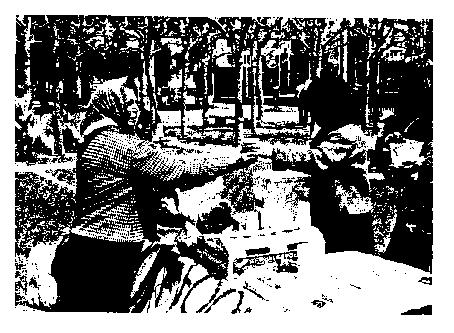
| Contents | Start | Previous | Next |
Eventually, work your way up to collecting at warehouses, firms, and wholesale distributors. The volume of food available to recover is immense, but be selective. Take what you can use from the highest quality. In many places, there is no need to recover commercial produce because there is plenty of organic produce to recover! In fact, one of our political messages is that there is more edible food being thrown away each day by the food industry than there are hungry people to eat it.
Food Distribution
At first, deliver the bulk food you collect to soup kitchens and pantries in your area. From your earlier research and contacts, it is likely that you will already know which kitchens are interested in receiving this food. Also, deliver bulk food to food pantries, striking workers, day-care centers, battered-women's shelters, refugees, and the like. Contact organizations already working directly in the community, and ask if their staff would take responsibility for equitable distribution of free food once a week. Since they already have a base of operations in the community, their staff know the people in need, how great their need is, and how best to distribute it to them. Encourage them to use the free food distribution program as a way to increase participation in their other programs; use the food as an organizing tool. Sometimes Food Not Bombs organizes the distribution of bulk food at housing projects or on street corners, but you might also give out bulk food along with the prepared meal at your food tables. One of our goals is the encouragment of the awareness of the food's abundance as well as the undermining of the market of scarcity that places profits before people.
The Kitchen
Once you have this network of collection and distribution in operation, begin using some of the recovered food to prepare hot meals. You will need to find a kitchen to use, and several pieces of equipment necessary for feeding large numbers of people that are not found in the average kitchen. A full equipment list can be found in the Recipes section.
There are several methods of finding suitable kitchen space. Sometimes
it is possible to arrange to use the kitchen in a community center, place
of worship, or public building. A large kitchen in a collective house or
a number of average-size kitchens also might be sufficient, but sometimes
cooking right on the street in a field kitchen is the best solution. Each
situation has its own advantages and disadvantages, and the demands ofyour
meal distribution program will determine your kitchen needs. Often, a combination
of kitchen spaces is necessary for different aspects of your schedule.
You might use a church kitchen for your weekly meal to die homeless,
a field kitchen for a large rally in a park, and a volunteers' kitchen
for a catered lunch. The key is finding the right-size kitchen for each
event.

| Contents | Start | Previous | Next |